
Alexander Heinle
Alex is a marketer at Zavvy. On this blog, he mainly shares insights gained from discussions with selected experts and from helping our customers set up and improve their onboarding or learning programs.

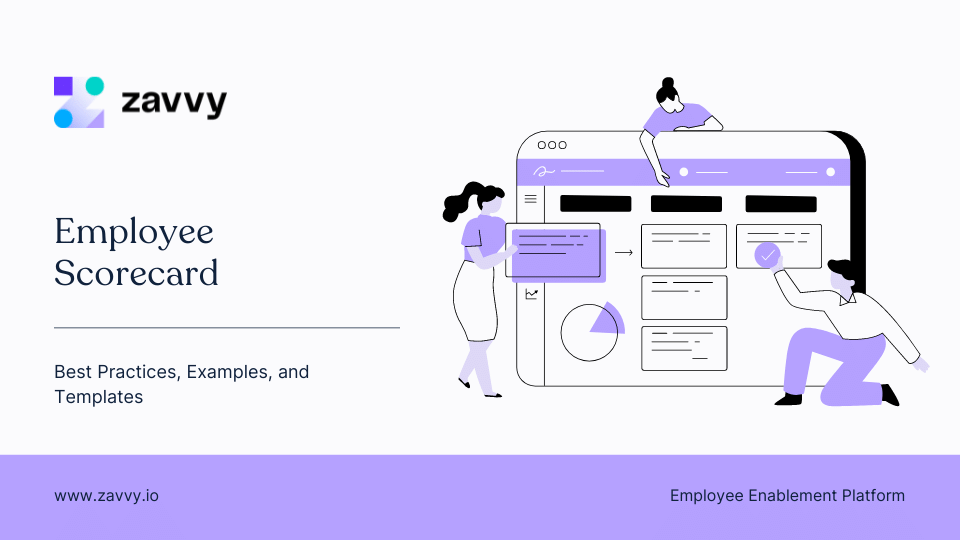
Many corporate spaces used to struggle with employee productivity. And most employees were either unsatisfied, lacked motivation, or both. This changed with the invention of the scorecard.
Since its introduction in the late 1990s, many companies have reported increased performance and lower employee turnover rates. It's a dynamic tool that can be used on a large scale and customized for individual employees.
Not only that, but the scorecard also encourages self-development. Join us as we take you through an in-depth review of employee scorecards, their benefits, and how to create one. As a bonus, we've also included employee scorecard examples.
Together with our curators, we have created a library of actionable digital marketing resources. Personalized to your team's needs.
An employee scorecard is a management tool used to monitor an employee's performance. It's the perfect organizational tool because it allows individuals to plan, prioritize, and implement required projects.
It outlines every individual's role and contribution to the workplace.
Plus, it allows people to focus on their roles, thereby improving their productivity. An employee scorecard also contributes to employee well-being (through clarity and affirmation) and encourages self-development.
Employee scorecards are used widely across different industries, including:
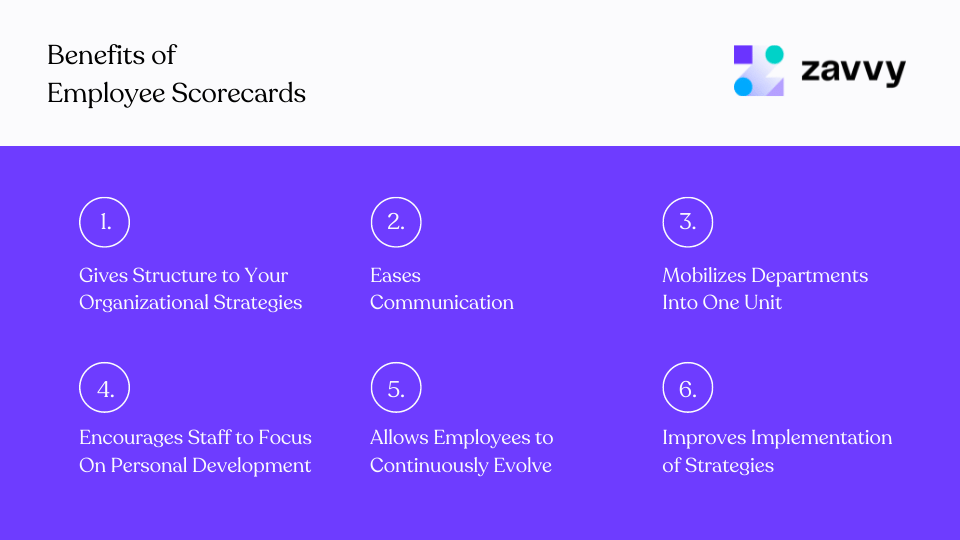
Different companies have unique sets of metrics to gauge individual employee performance progress.
An employee scorecard merges these approaches into a single unit that all organization members can use. It provides a clear and logical structure to which every employee adheres.
An employee scorecard makes communication easier by ensuring everybody is working towards the same goal. It provides a clear structure that employees can refer to whenever making significant decisions. Similarly, it makes managing company performance and development easier by centralizing all operations onto the scorecards.
A performance scorecard rallies all departments to work together towards the company's objectives. It provides a framework summarizing the necessary steps for implementing a specific strategy. Thus, employees work as a unit to achieve the same performance and development goals.
A KPI scorecard requires every individual to be at the top of their game, at work, and in their personal lives.
Individuals are encouraged to create personal scorecards to monitor their performance. It gives them the drive to improve their skills and encourages self-improvement.
Besides, it complements self-development practices such as time management and goal setting.
A scorecard allows employees to predict and align their practices with future trends. Thus, they can stay ahead of their competitors. Employees can also anticipate future challenges and devise solutions before affecting development and performance.
An action plan is a vital component of a performance scorecard. It provides the necessary framework to facilitate the execution of development strategies.
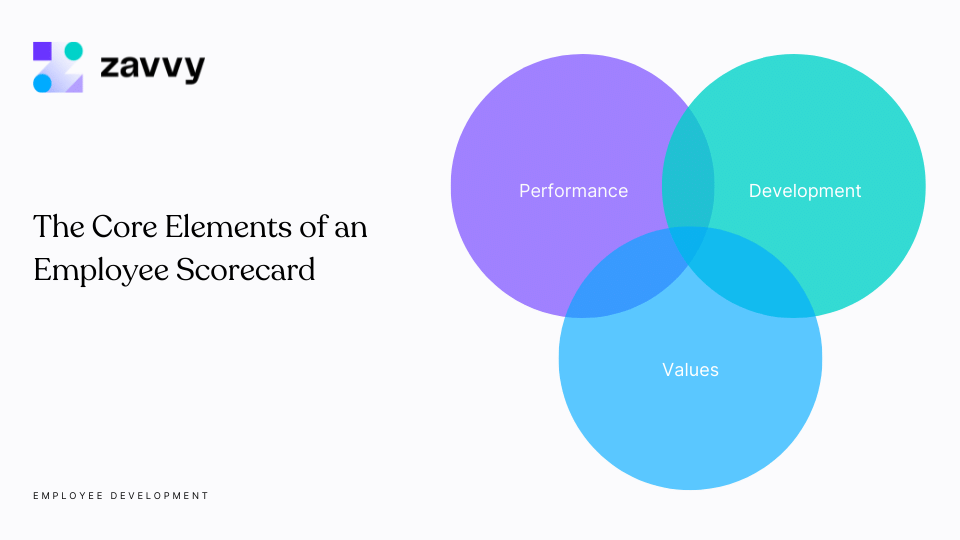
Along with standard info such as name and role, a typical employee scorecard should contain the following key elements:
These are the goals that the individual is working towards.
An employee scorecard should contain an overview of your business goals and objectives. This overview is known as a strategy map. It's beneficial during the planning and execution of a company's policies. Your strategy map should contain four crucial perspectives:
Your financial perspective should contain employee performance metrics such as:
These can be used to evaluate and gauge the employee's performance in terms of finances. They can be broad or specific and vary, depending on your overall goals.
Consumers are the backbone of any business enterprise. Thus, you must factor them in when creating an employee scorecard. It should contain various customer metrics such as:
These measures help you understand your customer base, allowing you to serve their needs better.
The internal perspective of a scorecard focuses on the company's organization. It measures how efficient its internal processes are and how effective they are at meeting their goals.
Besides, the internal perspective identifies areas that aren't operating at maximum efficiency, allowing teams to make the required adjustments. These variables include:
This perspective focuses on the organizational capacity of your company. It factors in the skills, technology, and knowledge necessary for the smooth running of the internal processes. These skills are also vital in ensuring consumers get value for their money, thereby improving customer satisfaction.
Learning and growth may vary according to your strategic goals. It includes metrics such as:
Metrics are used to track and measure a company's growth. They are essential in comparing an organization's progress against its goals and weed out any practices that may prevent it.
Below are examples of scorecard metrics:
The first step to creating a KPI scorecard is interviewing employees to get their take on the company's goals. Then, get their suggestions on what action plan aligns with the workplace values.
Strategic goals pinpoint what you want your company to accomplish. Everyone within the organization should have these goals in mind as well. In addition, the goals should align with the company's values.
No performance scorecard is complete without incorporating a strategic map. The map consists of the four perspectives mentioned above; financial, internal, customer, and learning and growth.
Metrics are used to measure a company's productivity. They exist in different categories, each catering to the various divisions of an organization. These divisions include:
They provide a clear projection of how effectively their strategies work with their goals. They also highlight the flaws in organizational processes, allowing team members to make the necessary adjustments.
Employee scorecards come in various formats, from digital to print. Some companies prefer digital versions such as PDF and Excel because they don't take up too much space and allow remote access. However, the print format may present a challenge in storage since the paperwork becomes bulky as it accumulates.
When conducting interviews, you'll find it easier to have a physical or digital copy of the KPI scorecard. This way, you can key in information and store it immediately.
Ranking people on performance does not feel great for everyone. Sometimes, a ranking can cause frustration. On the other hand, the reality often is that we're handling with business metrics and there always are results behind it.
Some suggest only filling the scorecard with a description - not with a numbered value. While having both can definitely makes sense, we at least ask you to make this a conscious decision.
The ranking system should take into account the following:
Most common are values ranging from 1-3 or 1-5.
You could use a numerical scale or one dependent on different variables. Furthermore, you should agree on the rating system during the interviews with your employees.
You can use the input collected from the sessions to develop a meaningful measurement scale. The scoring system keeps the employees motivated by giving them a target. It also ensures equality and promotes accountability.
An action plan on your scorecard provides a clear structure and delegates roles to employees according to their strengths. It also allows for continuous monitoring and evaluation. Lastly, an action plan enables team leaders to identify and solve possible challenges.
This step involves executing the strategies and measures in the prior stages. Every employee should perform their roles according to the strategic and developmental goals.
Review the employee scorecards regularly to ensure they align with their strategic goals. They also allow team leaders to continuously improve their practices for even higher performance.
The frequency of evaluations depends on the company's organization process but should typically be weekly or monthly. Hold sessions where employees can share and offer feedback on how to improve on their pain points.
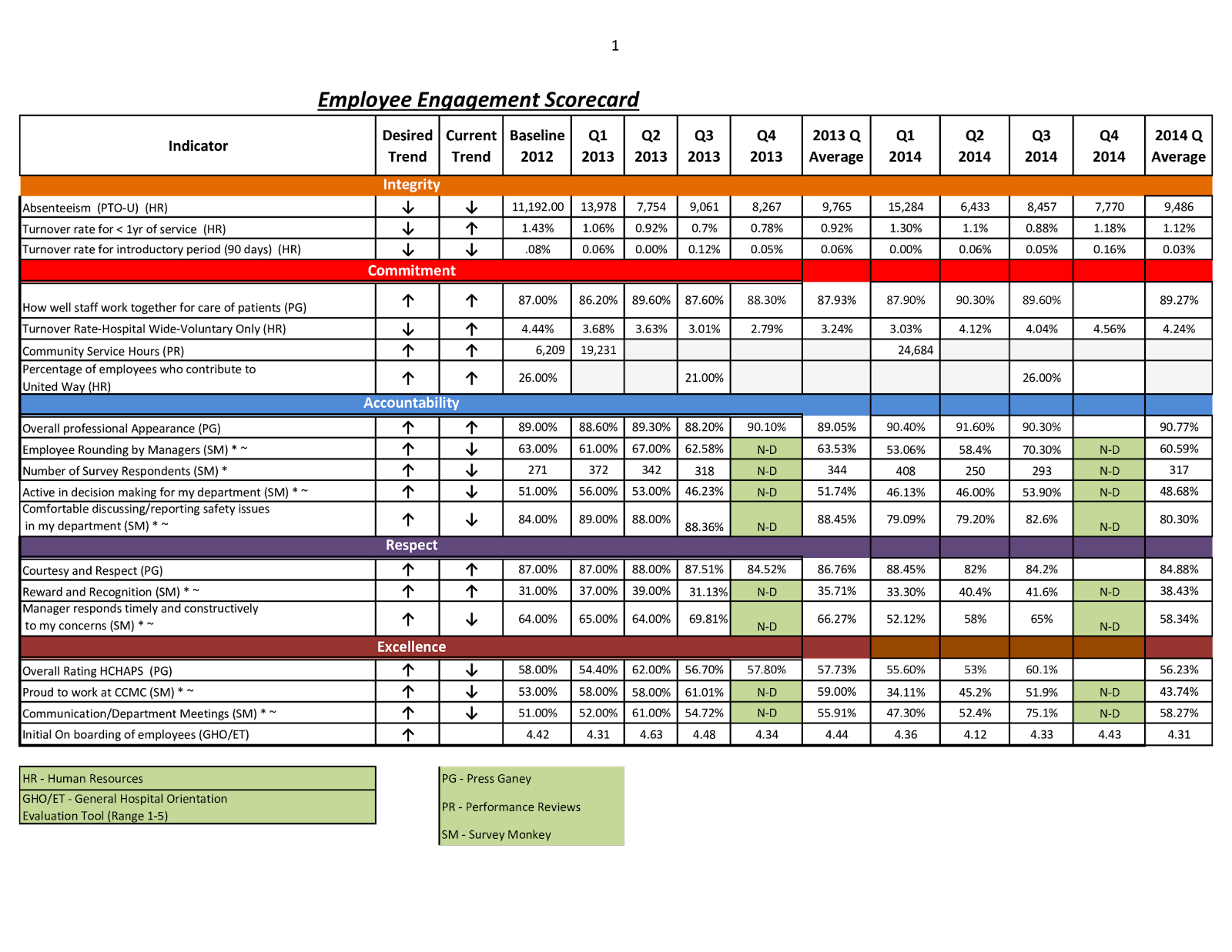
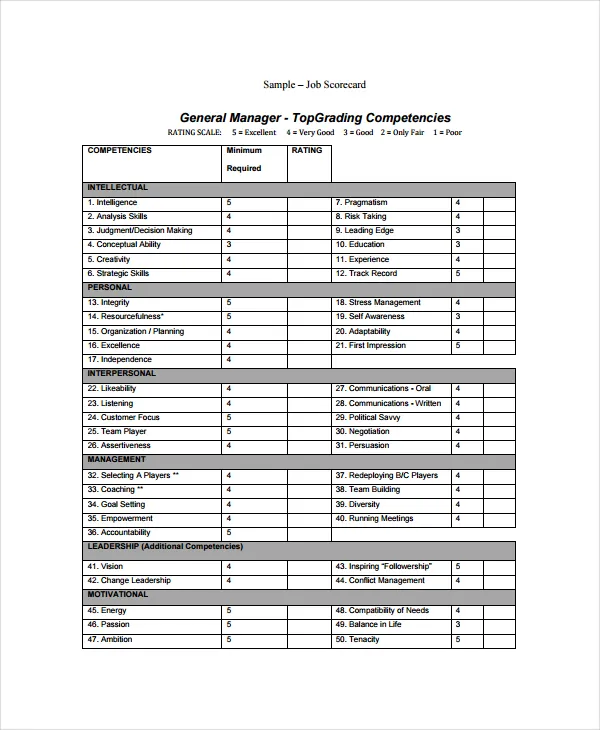
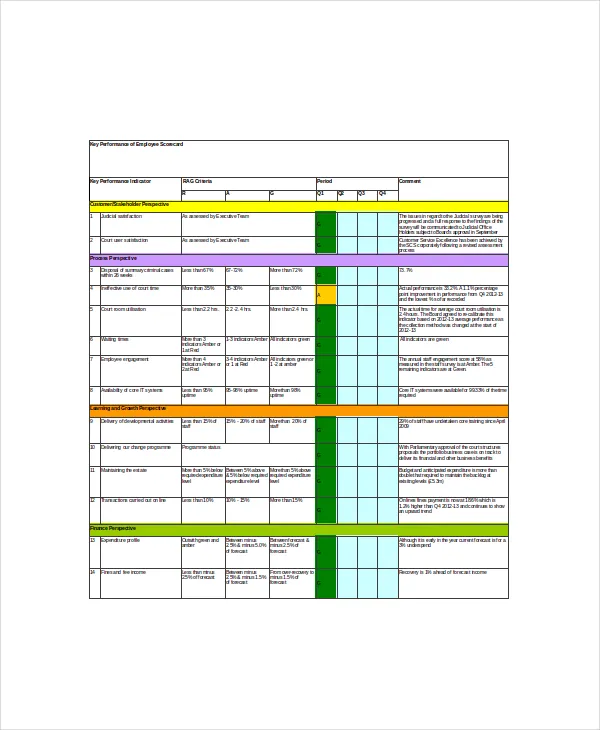
An employee scorecard requires continuous evaluation for it to run effectively. Involve your employees when coming up with a review cycle. Encourage them to share their results through open forums to further source ideas and solutions to improve their performance.
Managers and team leaders should note frequently reminding employees of their goals. The continuous check-ins keep them motivated and troubleshoot any potential challenges.
You can easily engage and remind employees of their goals with our Goal Companion template on Zavvy.
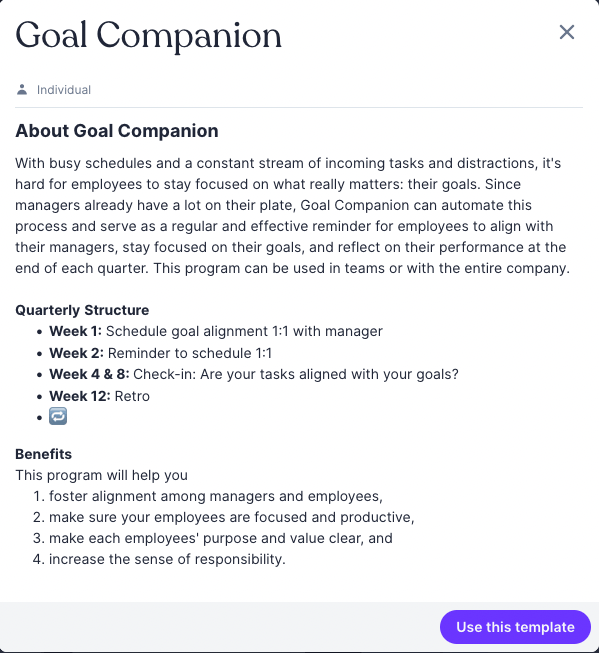
This is a checklist detailing the necessary steps to meet your company's strategic goals. It's a vital component in creating an employee scorecard because it makes it easier to track progress. It also improves cooperation by highlighting each person's role.
The action plan should contain:
An action item is a specific task that requires completion within a given timeframe. It is usually assigned to a single individual. An action item answers three questions:
It helps improve overall performance since every individual clearly defines their task. Managers assign action items during staff meetings.
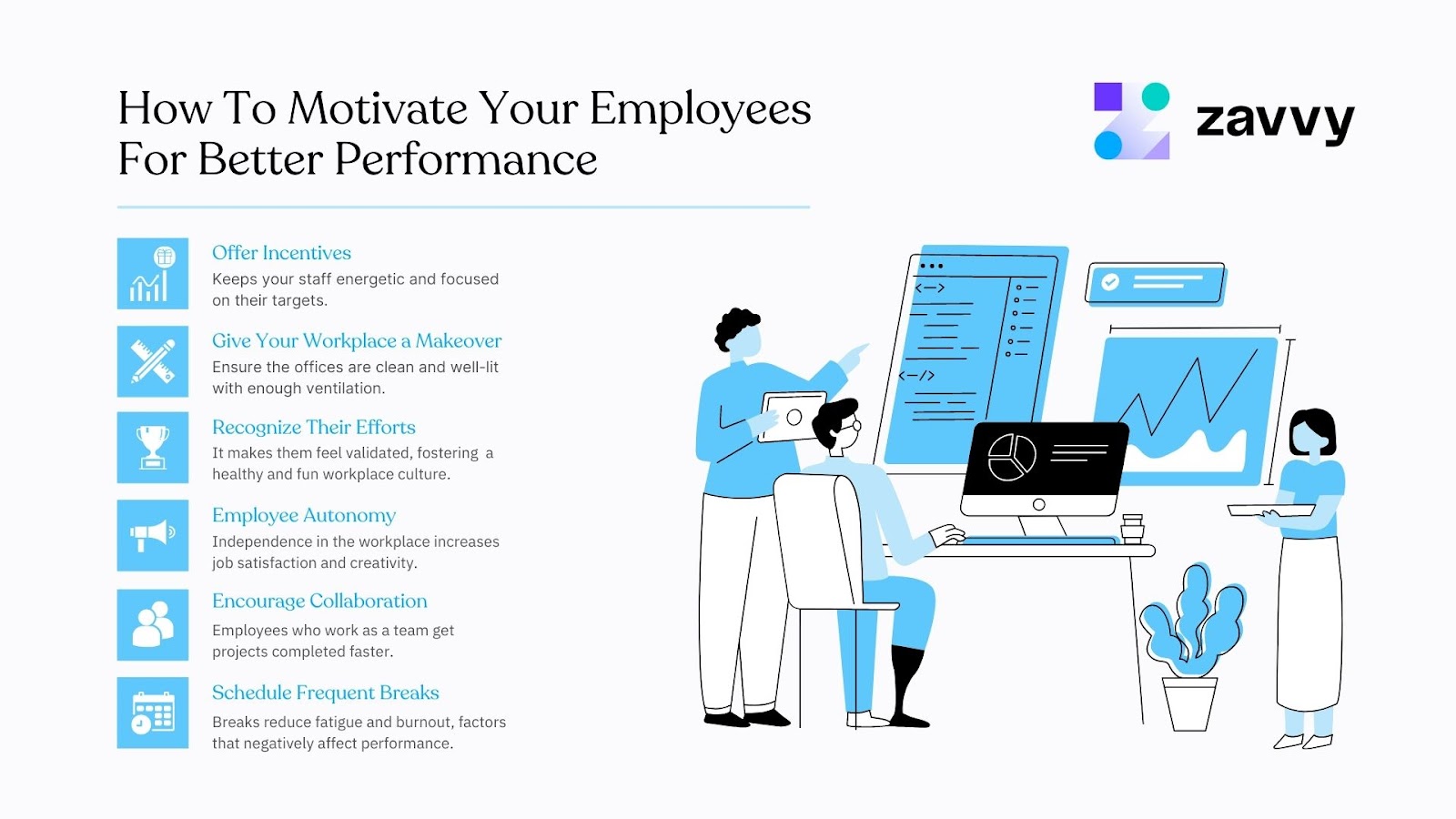
While performance is not the only KPI you should look at, it is a key component of scorecards. Here are a few ways to enhance it through motivation.
Consider introducing rewards such as bonuses every time an employee meets their goals on their scorecard. These shows of appreciation are guaranteed to keep your staff energetic and focused on their targets.
Here are a few ideas for your incentive program:
A good work environment can significantly boost your workers and clients. Ensure the offices are clean and well-lit with enough ventilation. Invest in air conditioning or big windows if your budget cannot stretch that far.
In addition, get comfortable desks and chairs for your staff, preferably orthopedic ones. Long hours hunched over a computer can cause back pain and other spine-related issues. Lastly, ensure the equipment is working efficiently. Regular maintenance increases their efficiency and shelf-life.
It can be a simple congratulatory message or a shoutout in your next general meeting. Recognizing when a worker does well boosts their performance and their self-esteem.
It makes them feel seen and validated, qualities that make the workplace healthy and fun. The positive feedback also increases job satisfaction and decreases employee turnover.
Employee autonomy is essential for improved performance. Nobody wants a boss who constantly micromanages them. In addition, studies show that independence in the workplace increases job satisfaction and encourages creativity.
You can encourage autonomy by giving your workers room to explore new ideas. For example, encourage open forums during meetings where all members can contribute.
"Alone, we can do so little; together, we can do so much."
– Helen Keller.
Collaboration is vital for any successful workplace. Employees who work as a team get projects completed faster. They're also likely to solve problems more quickly than those who work individually.
Studies have proven that frequent short breaks during work hours increase productivity and boost motivation in employees. In addition, these breaks reduce fatigue and burnout, factors that negatively affect performance.
They also break the monotony of work, giving employees time to decompress. In the same way, frequent breaks boost creativity in your employees.
An employee scorecard is perfect for improving performance in the workplace. It's a multifaceted tool that not only boosts productivity but also encourages self-development.
Creating a KPI scorecard doesn't have to be hard:
You'll also need an action plan for goal tracking. Lastly, evaluate your progress frequently to make sure you stay on track. I recommend setting up scorecards for your workplace today for improved performance.
A dashboard is a collection of visual information such as charts and graphs used to track a company's performance. It provides quick and accurate results of the operational activities of an organization.
On the other hand, scorecards are tools designed to manage an organization's performance concerning its goals. They are used to track KPIs and are updated periodically, typically once every month.
Companies that use a scorecard include:
Upskill your team every week with the best contents and personalized recommendations.

Many corporate spaces used to struggle with employee productivity. And most employees were either unsatisfied, lacked motivation, or both. This changed with the invention of the scorecard.
Since its introduction in the late 1990s, many companies have reported increased performance and lower employee turnover rates. It's a dynamic tool that can be used on a large scale and customized for individual employees.
Not only that, but the scorecard also encourages self-development. Join us as we take you through an in-depth review of employee scorecards, their benefits, and how to create one. As a bonus, we've also included employee scorecard examples.
Get a demo!
We'll be happy to show you around and answer all your questions.
Trusted by innovative companies



We'll be happy to show you around, answer your questions, or arrange a free trial.
Erhalten Sie eine kostenlose Demo unserer Onboarding-Software.
Vertraut von



Your Training & Development Strategy - Solved in 1 Tool.
Trusted by innovative companies



We'll be happy to show you around, answer your questions, or arrange a free trial.
Learn how Zavvy helps you drive performance, development, and engagement.
Trusted by innovative companies



We'll be happy to show you around, answer your questions, or arrange a free trial.
We'll be happy to show you around and answer all your questions.
Trusted by innovative companies



We'll be happy to show you around, answer your questions, or arrange a free trial.
Gerne zeigen wir Ihnen ganz unverbindlich unsere Plattform im Detail.
Vertraut von modernen Unternehmen



Get a demo!
We'll be happy to show you around and answer all your questions.
Trusted by innovative companies



We'll be happy to show you around, answer your questions, or arrange a free trial.
Erhalten Sie eine kostenlose Demo unserer Software für Mitarbeiterenwicklung und Training.
Moderne Unternehmen
setzen auf Zavvy


